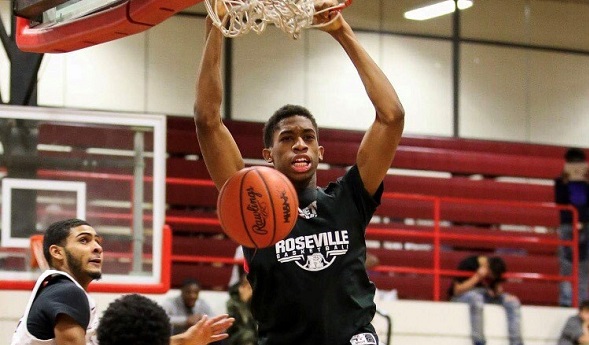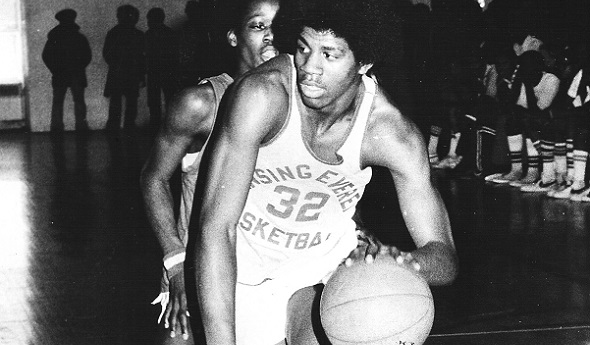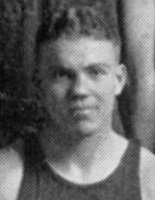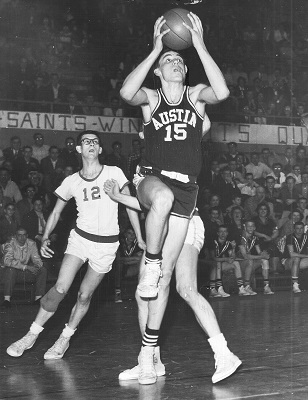
New Reality has Roseville Dreaming Big
By
Tom Markowski
Special for Second Half
January 30, 2019
ROSEVILLE – Something happened last February that produced a dramatic effect on the Roseville boys basketball team.
 It’s difficult for Roseville coach Hassan Nizam to put into words – but he’s certain that his team’s trip to Ann Arbor to play Pioneer and, more importantly, their visit to the Crisler Center to watch a University of Michigan practice had a positive impact on last year’s team and the program as a whole.
It’s difficult for Roseville coach Hassan Nizam to put into words – but he’s certain that his team’s trip to Ann Arbor to play Pioneer and, more importantly, their visit to the Crisler Center to watch a University of Michigan practice had a positive impact on last year’s team and the program as a whole.
“(The U-M staff) gave us a tour,” Nizam said. “It was eye-opening. There was something about it. I can’t even explain it. We’ve lost twice since. Maybe it turned them into dreamers.”
Roseville won seven straight after losing that game to Pioneer before a 44-39 defeat to Macomb Dakota in a Class A Regional Semifinal ended the Panthers’ season.
They’ve stormed back this winter and sit 13-1 entering the final month of the regular season, with their only loss coming at Dakota, 55-52, in the fifth game. Roseville avenged that loss with a 63-56 victory at home Jan. 15 and is ranked No. 3 in Division 1 in the latest Associated Press poll.
The Panthers are 8-1 in the Macomb Area Conference Red and have clinched a share of the title. They can win it outright with a victory at Sterling Heights Stevenson on Monday.
After that and over the next two months, Roseville is shaping up as a possibility to not only make school history, but carry its entire area into an elite scenario for the first time.
Teams from Macomb County have rarely been relevant come tournament time. Not only has a Macomb County team never won a Class A (now Division 1) title, the county has never been represented in a Class A Final in boys basketball. Warren DeLaSalle made the Class B Final in 1982 and has come close to breaking that county barrier, reaching Class A Semifinals in 1986, 2007 and last season. Dakota also lost in the Class A Semifinals in 2016.
Enter Roseville. The program has had limited success in the MHSAA Tournament – last season the Panthers finished 16-7 and won just the fourth District title in program history. They’ve never won a Regional.
Talent has come through in the past, but didn’t always guarantee a postseason run. Sir’Dominic Pointer (known as Dominick Pointer while attending Roseville) played two seasons at Roseville before transferring to a prep school in North Carolina, then played collegiately at St. John’s and was selected as the 53rd pick in the 2015 NBA Draft by Cleveland. He is currently playing professionally in Israel. Still, Roseville was not able to get past the District round in either of his seasons.
But on the positive side, this team is coming off that District title and has plenty of experience to go with ability. Four starters are back including seniors Darien Banks, Lazell Judge and John Ukomadu. The other returning start is junior point guard Martell Turner who, if he isn’t the team’s best, is likely the team’s most important player. The fifth starter is senior Deshaun Wright.
At 24, Nizam is one of the state’s youngest head coaches and his upbeat coaching style has had a rippling effect. This attitude impressed those who were responsible for hiring him, notably school principal Pat Adams.
“Our search for a new coach was centered on someone who loved kids and was passionate about the game,” Adams said. “In Coach Niz, we struck gold on both accounts. A big part of changing the culture in a building is to have the kids believe in themselves, feel pride in who they represent, and respect the leaders who spend time with them. We believe Coach Niz has demonstrated that he's a very important part of that formula and will continue to be as the program evolves.”
A 2012 graduate of Dearborn Fordson, Nizam spent three seasons as the junior varsity and varsity assistant at Fordson before becoming an assistant at U-M Dearborn for the 2016-17 season. Nizam said one of his first objectives when he was hired at Roseville in May of 2017 was to build consistency.
 “I was just an assistant coach looking for an opportunity,” he said. “As far as the program here, I knew they had had some success. The transition was pretty smooth, and the kids bought in. (Sir’)Dominic stops by every now and then, and the kids appreciate that. The guys have to understand that individual success comes from team success.”
“I was just an assistant coach looking for an opportunity,” he said. “As far as the program here, I knew they had had some success. The transition was pretty smooth, and the kids bought in. (Sir’)Dominic stops by every now and then, and the kids appreciate that. The guys have to understand that individual success comes from team success.”
Last season was one of the most successful in school history. As a member of the MAC White, Roseville competed in the MAC Red/White division playoffs and defeated Clinton Township Chippewa Valley for the title. Two weeks later, Roseville won the District title by defeating St. Clair Shores Lake Shore 80-77.
Roseville opted to move up to the MAC Red this season, and one result is a more competitive schedule. In addition to the increase in competition the Red affords, the Panthers defeated DeLaSalle to open the winter, then defeated Division 2 contender New Haven at New Haven and slipped past Cincinnati Withrow (Ohio), 42-39, at the Motor City Roundball Classic.
“We kind of have the approach that we want to get better each game,” Nizam said. “We’ve got a chance to win the MAC Red, the MAC title, a District title and a Regional. It’s that day-to-day thing we like to emphasize.”
What makes this team better than last season’s is Roseville’s play on the defensive end. The players are communicating better, switching assignments when teams run a motion offense and playing help defense.
In Roseville’s 65-60 victory over New Haven, the Panthers held Romeo Weems – New Haven’s best player and a likely candidate for the Mr. Basketball Award – to 20 points. As a team, Roseville has allowed 45 points per game. And just one team, New Haven, has scored in the 60s.
“That New Haven game was big for us,” Nizam said. “They hadn’t lost a game at home in like six years. We weren’t going to let Weems beat us. Our kids believed in each other that game. After that, their confidence went way up. It showed we can be a problem for any team.”
Offensively, Roseville likes to score in transition, but its half-court sets have improved since last season as well. Banks is an accurate 3-point shooter and leads the team in scoring at 21 points per game. Turner is the table-setter who averages seven assists. Ukomadu is a 6-foot-7 post player who jumps well, and Judge is a 6-1 lefty who plays the wing.
Wright is a 6-3 power forward who possesses a good mid-range jump shot. And he’s one example of why the program has shown promise and is on the rise. Wright never played high school basketball before this season. He played basketball in middle school before concentrating on football his first three years of high school.
Wright saw the success the team had last season and, in the end, it was Nizam’s coaching style that won him over.
“I caught a few games at the end of last year,” Wright said. “I liked (Nizam’s) enthusiasm. He wants to win as much as we do. He wants it just as bad as we do. My mom (Ruth Wright) told me, to be a two-sport athlete coming out of high school would help me in college. I would love to play either one in college.”
Wright has yet to decide on which school he will attend next fall, and he is expected to take a visit to Urbana University in Ohio before making his decision.
In the meantime, Wright’s focus is on his teammates and continuing what they together have started.
“Once we step on the floor, we’re connected,” he said. “Our goal is to get better every game.
“Sharpen the ax. And we are getting better every day. I know by the way we compete against each other in practice.”
 Tom Markowski is a correspondent for the State Champs! Sports Network and previously directed its web coverage. He also covered primarily high school sports for the The Detroit News from 1984-2014, focusing on the Detroit area and contributing to statewide coverage of football and basketball. Contact him at [email protected] with story ideas for Oakland, Macomb and Wayne counties.
Tom Markowski is a correspondent for the State Champs! Sports Network and previously directed its web coverage. He also covered primarily high school sports for the The Detroit News from 1984-2014, focusing on the Detroit area and contributing to statewide coverage of football and basketball. Contact him at [email protected] with story ideas for Oakland, Macomb and Wayne counties.
PHOTOS: (Top) Roseville’s John Ukomadu throws down a dunk during a scrimmage. (Middle) Panthers players huddle with coach Hassan Nizam. (Photos by Brian Sevald Photo.)

'Retro' Award Rewards 1st Hoops Legends
January 4, 2017
By Ron Pesch
Special for Second Half
Before the start of the MHSAA’s 2009 Boys Basketball finals, Basketball Coaches Association of Michigan director Tom Hursey stopped by my seat at Michigan State University’s Breslin Center to say hello.
Our chat would alter a decade of my Michigan winters.
Somewhere between hello and goodbye, our chat included conversation on one of my favorite BCAM ventures. In 1981, the Michigan High School Basketball Coaches Association, as BCAM was once known, named its first “Mr. Basketball.” I was two years out of high school when Lansing Eastern’s Sam Vincent edged Eric Turner of Flint Central for that first award. Designed to honor the state’s top senior, the award was named in honor of Detroit Free Press writer Hal Schram. “The Swami,” as he was nicknamed, Schram began covering high school sports for the newspaper in 1945.
The 2009 selection was 6-foot-9 Derrick Nix of Detroit Pershing. I mentioned my affinity for the Mr. Basketball program to Tom, but stated that I always thought it a crime that the award didn’t start years earlier, at least when Michigan hoop fans became infatuated with a kid nicknamed “Magic.”
Earvin Johnson prepped at Lansing Everett and was the talk of the state in basketball circles before becoming a household name during his time at Michigan State and with the Los Angeles Lakers. Earlier this year, ESPN named Johnson the greatest point guard to ever play the game. Tom noted that “Magic” was really the inspiration for the “Mr. Basketball” award.
Then I posed a question to Tom.
What about creating a “new” award, designed to honor those greats from the past?
As my hobby of researching the history of high school sports in Michigan and beyond had grown over the years, I’d found the Great Lakes state had always produced shining stars on the basketball court. The crime was that the “Mr. Basketball” award hadn’t been launched many years before.
Harry Kipke, was perhaps the state’s first true basketball star. He won 12 varsity letters at Lansing Central and guided the basketball team to the semifinal round of the state tournament in 1920 as a senior, before heading to the University of Michigan where he earned letters in football, basketball and baseball. After stops at the University of Missouri and Michigan State, Kipke would serve as Michigan’s football coach, guiding the Wolverines to two national gridiron championships.
 As a junior, the basketball antics of Grand Rapids Union’s Royal “Red” Cherry captured the state’s attention when he led Union to the state basketball championship. Considered the best all-around player of the tournament, Cherry led the team to a second consecutive title as a senior. He, too, attended Michigan, earning laurels on the basketball court and the baseball diamond.
As a junior, the basketball antics of Grand Rapids Union’s Royal “Red” Cherry captured the state’s attention when he led Union to the state basketball championship. Considered the best all-around player of the tournament, Cherry led the team to a second consecutive title as a senior. He, too, attended Michigan, earning laurels on the basketball court and the baseball diamond.
Many other legends of the hardcourt populated Michigan’s past: Saginaw’s Ernie Thompson; the Burton brothers, M.C. and Ed, of Muskegon Heights; Detroit Pershing’s Ralph Simpson and Spencer Haywood; Dave DeBusschere of Detroit Austin Catholic; Willie Betts and Blanche Martin of River Rouge; Ron Kramer of East Detroit; Benton Harbor’s Chet Walker and L.C. Bowen.
After a few weeks of research, discussion and thought, Tom agreed, and over the next several months the framework for the “Retro Mr. Basketball” project was developed
The idea was to try and mimic the current model. Only seniors, and their high school basketball careers, should be considered. While any “senior” player would be eligible, a ballot of the state’s elite would comprise the candidates for the award. Like their modern-day equivalents, where the events of life that would follow high school graduation had yet to occur, post-high school life would be disregarded as much as possible for “Retro” candidates.
Finally, the program would follow a 10-year arc, kicking off in the spring of 2010. This December marks my eighth year of research tied to the mission. Two more will follow.
Since the Schram “Mr. Basketball” award began in 1981, the “Retro” award would honor basketball players from the years 1920 through 1980. That first year, a ballot comprised of players from the years that ended in zero - 1920, 1930, 1940, 1950, 1960, 1970 and 1980 – was created. A senior for each year would be named the winner of the “Retro” award. That meant with the selection of “Mr. Basketball” and the six “Retro” winners for the years 1929, 1939, 1949, 1959, 1969 and 1979, scheduled for the spring of 2019, BCAM would be able to point to a combined list of Mr. Basketballs totaling 100 of the state’s finest.
To identify each year’s award winner, a committee of veteran BCAM members was formed to study a ballot of candidates and select a winner.
Technology, combined with scanning old-fashioned reels of microfilm, has helped with research of potential candidates. In those very early years, personal statistics were rarely kept. Rather, an assessment of a player’s skills, tied to the position he played, often served as a means to identify an area’s top athletes. Tournament play was often the only time an athlete’s abilities were on display to a larger audience. Scouring newspaper articles for all-tournament teams and yearbooks for additional details and years of study helped uncover the state’s top senior players. Understanding the game and its evolution was important. The center jump after each basket emphasized the importance of a tall, skilled center in those games played before the winter of 1938-39.
Beginning in 1935, all-state teams began to appear in state newspapers. Eventually, the Detroit Free Press, the Detroit Times, the Detroit News, The Associated Press and even United Press International became involved in identifying the state’s top basketball players and naming all-state squads. Much work is involved in parsing the 15,811 names (not including honorable mentions) found in those lists. When duplicates are removed, the names of 8,430 prep players remain spread over the 61 years that mark the “Retro” field of possible candidates.
Research to identify seniors, players named by multiple media outlets, and mini biographies are compiled for the top players. The field of candidates is then narrowed to 10 or fewer. Over state championship weekend, the ballots are brought to the BCAM committee for discussion, and finalists are named for each year. Finally, one player is named for each eligible season.
Like the modern day award, the selection may create some controversy. Some amazing ballplayers have landed on the finalist list, but were denied the Hal Schram Mr. Basketball award: Traverse City’s Dan Majerle, Roy Marble of Flint Beecher, Detroit Southwestern’s Jalen Rose, Detroit Northern’s Derrick Coleman and Draymond Green of Saginaw are among a few.
 The same applies to the “Retro” list. Fennville’s Richie Jordan, Robert “Bubbles” Hawkins from Detroit Pershing, Dennis Bankey of Detroit St. Thomas, Bill Chmielewski of Detroit Redeemer, Highland Park’s Terry Duerod and Detroit Kettering’s Lindsay Hairston all have been honored on the finalist lists, but fell short of the top prize.
The same applies to the “Retro” list. Fennville’s Richie Jordan, Robert “Bubbles” Hawkins from Detroit Pershing, Dennis Bankey of Detroit St. Thomas, Bill Chmielewski of Detroit Redeemer, Highland Park’s Terry Duerod and Detroit Kettering’s Lindsay Hairston all have been honored on the finalist lists, but fell short of the top prize.
In many cases, Michigan was loaded with prep talent – it’s tough to name Roy Marble Mr. Basketball when Flint Northwestern’s Glen Rice was on the same ballot, or Rose the state’s best when Country Day’s Chris Webber was another candidate. While the “Fennville Flash” amazed the state with his eye-popping statistics in 1965, Bowen led Benton Harbor to back-to-back Class A titles. Named an all-state basketball player as a junior, Hairston grew an inch and improved his game as a senior, but Pontiac Central’s “Campy” Russell dominated headlines that season, and was the “Retro” Mr. Basketball selection for 1971.
In some cases, it’s a challenge to look at the final balloting results without judging selections based on future basketball success. That certainly is the case with 2008. That season, Michigan’s Mr. Basketball award went to 6-foot guard Brad Redford, who posted incredible back-to-back high school seasons at Frankenmuth. Runner-up to the award that year was Saginaw’s Green. Considering Green’s success in the NBA, that’s hard for many to believe.
While the debates may never be settled, the beauty of Schram and “Retro” Mr. Basketball balloting can be found in the argument. With those disputes, people recall, research and learn about Michigan’s incredible prep basketball past.
The remaining three years of the “Retro” project will include many more legends of Michigan High School basketball, including, among others, DeBusschere, Walker, Haywood and Simpson.
This season, that “Magic” kid will be one of the names among the mix. Forty years after high school graduation, will he earn the honor that eluded him in high school, only because the honor didn’t yet exist?
 Ron Pesch has taken an active role in researching the history of MHSAA events since 1985 and began writing for MHSAA Finals programs in 1986, adding additional features and "flashbacks" in 1992. He inherited the title of MHSAA historian from the late Dick Kishpaugh following the 1993-94 school year, and resides in Muskegon. Contact him at [email protected] with ideas for historical articles.
Ron Pesch has taken an active role in researching the history of MHSAA events since 1985 and began writing for MHSAA Finals programs in 1986, adding additional features and "flashbacks" in 1992. He inherited the title of MHSAA historian from the late Dick Kishpaugh following the 1993-94 school year, and resides in Muskegon. Contact him at [email protected] with ideas for historical articles.
PHOTOS: (Top) Lansing Everett’s Earvin Johnson drives around a defender during his celebrated high school career. (Middle) Grand Rapids Union’s Royal “Red” Cherry. (Below) Detroit Austin Catholic’s Dave DeBusschere drives to the hoop as an opponent gets in position to rebound. (Photos from MHSAA and Ron Pesch historical files.)

